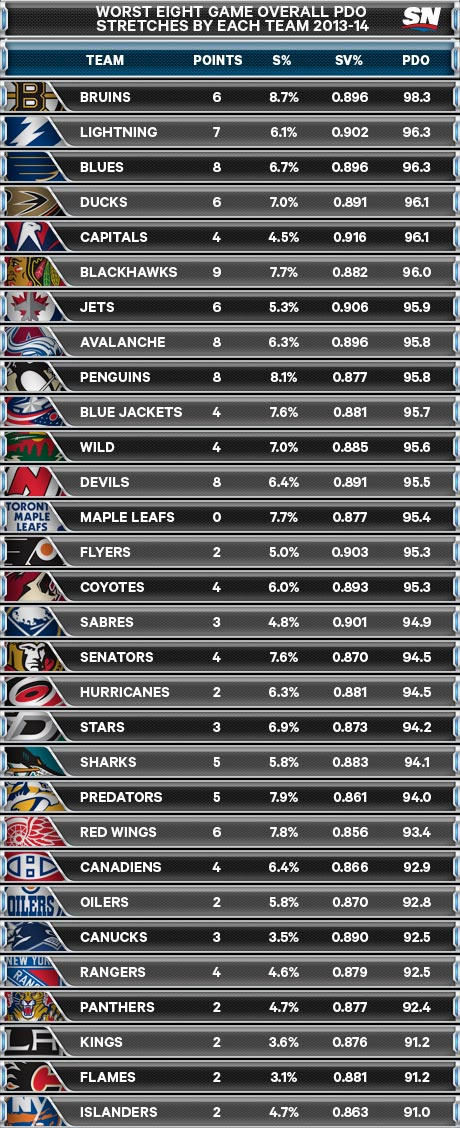Three weeks ago, I wrote something on this site that prompted a lot of commenters to tell me, in some cases quite frankly, that I was wrong. When I make a mistake, I admit it.
My description of the Maple Leafs as “almost certain to make the playoffs” and “a near-lock” has not aged well. While I just skimmed the hostile comments, I assume that the people screaming at me at the time felt that I was far too optimistic about Toronto’s’ chances and not because I said that, record notwithstanding, the team wasn’t very good.
So what happened? The short answer is that the Leafs went through a stretch where the puck just wouldn’t go in and their goalies couldn’t keep it out of their net. The more interesting question is whether they really collapsed or if this was just one of those things that happens, and happened at a spectacularly inopportune time.
Almost six years ago, in one of the dark corners of the Internet where hockey stats are discussed by nerds, a group of Oilers fans were kicking around the local hockey team’s struggles. (Nothing ever changes for Oilers fans.) A fellow going by the handle PDO had an idea. He suggested that, in the short run, there was a lot of luck in whether pucks went into the net or not. He pointed out that we could express this idea by adding the shooting percentage and save percentage when a player was on the ice. Hockey stats guys are pretty terrible at naming things, so this stat got named PDO. It’s usually used just for 5v5 play but it can be used in all situations.
If a team’s PDO is above 100, it’s probably getting somewhat lucky. If it’s below, they’re probably not catching many breaks. The further away a player (or team) is from 100, the more likely some regression towards 100 is. As a rule, most teams will be between 102 and 98 over the course of an entire season. Even at that, teams that are at the extremes in one season (2012-13 Toronto Maple Leafs 5v5 PDO: 103) tend to see it be a lot closer to 100 the following season (2013-14 Toronto Maple Leafs 5v5 PDO: 101.3).
PDO can be helpful in cases where we want to understand whether a bad stretch is particularly noteworthy. In order to provide some context for what the Leafs went through, I’ve assembled a list of each team’s worst eight-game stretch of PDO in 2013-14, as well as how many points they got out of it.
You’ll notice that teams’ bad PDO stretches coincided with bad stretches generally. Moreover, without exception, every team this year has gone through an eight-game stretch in which its PDO was well below 100. It’s just how hockey works. Judging by this, as unpleasant as those eight games were for the Maple Leafs, they really didn’t have it too bad in terms of PDO relative to what other teams have suffered through at some point this year. Most teams have had a worse stretch. Prior to these eight games, the Leafs’ worst run this season was a 97.5 PDO stretch in early January.
The irony in all of this is that the Leafs were probably unlucky not to get a few points out of these eight games—a couple of games going to overtime or a win. Nobody else in the NHL has failed to get at least two points out of their bad PDO run; the average is around 4.5 points. Even four more points would have the Leafs in the playoff discussion. Of course, Toronto is in a uniquely terrible position to moan about a failure to get any OT/SO points lately. As I noted three weeks ago, they’d had an extraordinarily high number of their games go to OT/SO to that point in the season and it wasn’t something that could be depended on going forward I just didn’t think that there was enough time left in 2013-14 to fall off the tightrope.
Given that most teams go through something similar to this, it seems misguided to look at this the PDO through this stretch of the season as necessarily being due to a Leafs flaw. On balance, their goalies have been very good this year and their shooters have done a fine job of finishing. The real problem that they have is the same one that they’ve always had: They’re in the business of getting badly out-shot.
When the Blackhawks go through a stretch like this, they have the fact that they out-shoot their opponents to help grind out points—it’s easier to get by on .880 goaltending and a 7.7 percent shooting percentage when you get 60 percent of the shots instead of 48 percent. But for Toronto, there’s no fallback.
Teams that get badly out-shot but have great goaltending and some players who can finish can win until it dries up. When it dries up—and it always does, whether it’s the third period in game seven or an eight-game stretch in March—it gets ugly. Earlier in the season, Leafs management didn’t want to hear any criticism of how they were winning. At the PrimeTime Sports Management Conference in November, Toronto GM Dave Nonis reflected on his time with the Leafs and said, “…right now our Corsi stat sucks. But we’re winning hockey games.”
What happened in Boston last year ought to have been the first red flag. This collapse should be the second.
The underlying issue is the same. Until the Leafs get serious about addressing it, this is what they are going to be: A team that can win on finishing and goaltending, and that is prone to devastating collapses. While the non-Leafs fan may enjoy it (Full disclosure: the author is not a Leafs fan and has found this, like game seven in Boston, to be great theatre.), it’s a lousy thing for the Leafs and their fans to go through. All the more so because it’s so unnecessary: If the problem was admitted, it could probably be solved.



